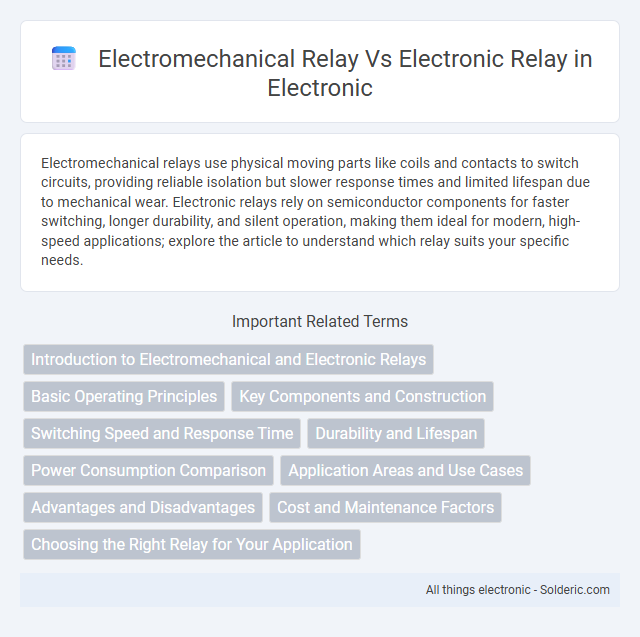Electromechanical relays use physical moving parts like coils and contacts to switch circuits, providing reliable isolation but slower response times and limited lifespan due to mechanical wear. Electronic relays rely on semiconductor components for faster switching, longer durability, and silent operation, making them ideal for modern, high-speed applications; explore the article to understand which relay suits your specific needs.
Comparison Table
| Feature | Electromechanical Relay | Electronic Relay |
|---|---|---|
| Operating Principle | Mechanical switching via electromagnetic coil and contacts | Solid-state switching using semiconductor devices |
| Switching Speed | Slower (milliseconds) | Faster (microseconds to milliseconds) |
| Durability | Limited mechanical life due to contact wear | Longer life, no moving parts |
| Contact Noise | Generates audible clicking noise | Silent operation |
| Current Capacity | Typically higher current handling | Usually lower current ratings |
| Power Consumption | Higher coil power consumption | Lower power consumption, efficient |
| Size | Generally larger | Compact design |
| Cost | Usually less expensive for simple applications | More expensive due to semiconductor components |
| Susceptibility to Vibration | Sensitive; mechanical parts prone to damage | Resistant; no moving parts |
| Applications | Heavy-duty switching, industrial control, motor starters | Signal switching, low power circuits, solid-state controllers |
Introduction to Electromechanical and Electronic Relays
Electromechanical relays use a physical moving coil and armature to open or close contacts, providing electrical isolation and the ability to switch high voltages and currents, while electronic relays (solid-state relays) utilize semiconductor components like transistors and optocouplers to switch circuits without moving parts. Electromechanical relays generally offer robust mechanical durability and can handle inductive loads but have slower switching speeds and shorter lifespans compared to electronic relays. Your choice between electromechanical and electronic relays depends on the application's speed, durability, noise tolerance, and power requirements.
Basic Operating Principles
Electromechanical relays operate by using an electromagnetic coil to mechanically open or close contacts, allowing current to flow through a circuit. Electronic relays, or solid-state relays, rely on semiconductor devices such as transistors or thyristors to switch circuits without moving parts, providing faster response times and longer durability. Understanding these operating principles helps you select the appropriate relay type based on application needs like switching speed, noise, and lifespan.
Key Components and Construction
Electromechanical relays consist of a coil, armature, spring, and mechanical contacts, relying on electromagnetic force to physically open or close circuits. Electronic relays, also known as solid-state relays, use semiconductor components such as thyristors, triacs, or transistors to switch circuits without moving parts. The absence of mechanical contacts in electronic relays results in faster switching, longer lifespan, and greater resistance to shock and vibration compared to electromechanical relays.
Switching Speed and Response Time
Electromechanical relays typically have slower switching speeds and longer response times, ranging from 5 to 20 milliseconds, due to their mechanical moving parts. Electronic relays, however, utilize solid-state components that enable switching speeds in the microsecond range, providing significantly faster response times for high-speed applications. Your choice depends on whether you prioritize durability and isolation, or rapid switching performance for precise control.
Durability and Lifespan
Electromechanical relays typically offer a lifespan of 1 to 10 million operations due to their mechanical contacts, but they are more prone to wear and tear from physical movement and arcing. Electronic relays, using solid-state components, boast longer durability and can reach up to 100 million switching cycles with minimal degradation since they have no moving parts. Your choice between these relays will depend on the required lifespan and durability for your specific application, with electronic relays generally preferred for high-frequency switching and extended use.
Power Consumption Comparison
Electromechanical relays typically consume more power due to the need to energize a coil to physically move contacts, often requiring tens to hundreds of milliwatts. Electronic relays, or solid-state relays, feature lower power consumption because they use semiconductor components like TRIACs or MOSFETs, operating efficiently with power requirements in the milliwatt range. This energy efficiency makes electronic relays more suitable for battery-powered or energy-sensitive applications.
Application Areas and Use Cases
Electromechanical relays are predominantly used in industrial automation, motor control, and power management systems where high current capacity and electrical isolation are critical, offering robust switching for heavy loads and harsh environments. Electronic relays, commonly found in telecommunications, signal processing, and low-power applications, provide faster switching speeds, longer lifespan, and silent operation, making them ideal for sensitive electronic circuits and smart devices. Both relay types serve essential roles in automotive electronics, home appliances, and control panels, with selection based on current ratings, switching frequency, and environmental conditions.
Advantages and Disadvantages
Electromechanical relays offer advantages such as high surge current capacity and physical isolation between the control and load circuits, but they suffer from slower switching speeds and mechanical wear over time. Electronic relays provide faster response times, greater reliability, and longer operational life due to the absence of moving parts, though they typically handle lower current loads and can be more sensitive to voltage spikes. Choosing between electromechanical and electronic relays depends on application requirements for durability, speed, load capacity, and environmental conditions.
Cost and Maintenance Factors
Electromechanical relays generally have lower initial costs but require more frequent maintenance due to mechanical wear and contact degradation. Electronic relays feature higher upfront costs yet offer longer lifespan and reduced maintenance needs because they lack moving parts. The choice depends on budget constraints and maintenance capabilities in the specific application environment.
Choosing the Right Relay for Your Application
Electromechanical relays offer mechanical switching with physical contacts, providing high current handling and electrical isolation, making them ideal for heavy-duty applications. Electronic relays, or solid-state relays, use semiconductor components to achieve faster switching, longer life, and silent operation, suitable for high-speed or noise-sensitive environments. Your choice depends on factors like load type, switching speed, durability, and electrical isolation requirements to ensure optimal performance and reliability.
Electromechanical relay vs electronic relay Infographic

 solderic.com
solderic.com